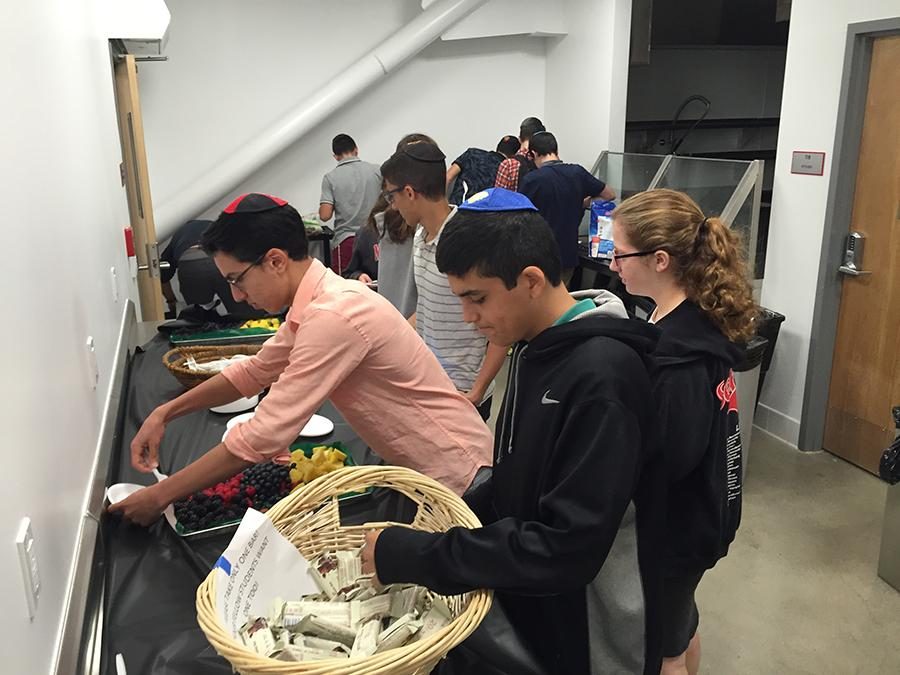Sugar cereal breakfast bites the dust
FUEL: Hashkama students take breakfast from the new, healthier selection. Items available on different days include almonds, Greek yogurt, fruit and protein bars.
November 16, 2015
The sugar content is going down at Shalhevet. This year, instead of sweetened morning cereals like Frosted Flakes and Fruit Loops, Shalhevet has introduced healthier choices like fresh fruit, yogurt and almonds.
Now, when students gather after davening for breakfast at the buffet in the kitchen area, they’re likely to see fresh fruit or yogurt, or toast with sunflower seed butter, or protein bars, apples and hard-boiled eggs – though not on the same day.
Breakfast used to be cereal and milk.Shalhevet Executive Director Ms. Robyn Lewis, who organized the new program, said the goal is to encourage a healthier lifestyle.
“The easiest way to go, and the cheapest way to go, is sugary cereals,” Ms. Lewis said. “But the truth is that’s not healthy, it’s not good for our students, and that’s not what we want to be teaching our students.”
The idea for a new breakfast came this year when Mrs. Joleen Julis, a clinical nutritionist and mother of sophomore Maia Julis, invited Head of School Rabbi Ari Segal to an event at her home about healthy eating.
The lecture intrigued Rabbi Segal, who brought the idea to Ms. Lewis.
“We’ve always wanted to have a healthier breakfast,” Ms. Lewis said. “We just didn’t really know how to go about doing it, and what to provide.” After meeting with Mrs. Julis, the pair put a plan together.
Over the course of a week, offerings now are fresh fruit, yogurt, almonds, granola, toast with sunflower seed butter or jam or cream cheese, protein bars, apples and hard-boiled eggs.
So far, reaction from students has been mixed. Most boys say they miss the cereal, while girls are more divided. Others complain that it runs out too soon.
“I do like that they have fruit as an option, and yogurt, because, I mean, it is better to have a healthy option, because I don’t usually eat fruit in the morning,” said freshman Hannah Merritt. “When I have it in front of me, I’ll take it.”
Sophomore Maya Rosen likes it most of the time.
“Some days it’s good, but the choices are very limited and sometimes it runs out,” said Maya.
Junior Bennett Schneier is less pleased.
“Not everyday I’m feeling jam on toast, but everyday I am down for cereal,” said Bennett. “Instead of Whole Grain Chex cereal, give me the Fruity Pebbles.”
Most days after breakfast, not much food is left. Fruit, sliced bread, granola and vanilla yogurt usually run out. That means less waste on leftovers, but students arriving after regular minyan complain the early-bird Hashkama students have eaten all the good stuff.
“I’m a big dude, and it’s not as much food as last year,” said junior Isaac Goor. “Tuesdays and Thursdays are actually the most pathetic thing I’ve seen in my life. It’s bread, sun butter and jam. It’s quite sad.”
Shalhevet tried a similar but more limited approach to a healthier breakfast two years ago, by moving from sugary cereals to less sugary cereals. Instead of brands like Frosted Flakes and Fruit Loops, they offered brands like Raisin Bran and Cheerios.
According to Ms. Lewis, the plan didn’t work because it was too limited and many students simply chose to stop eating the breakfast altogether. This time, with a broader array of choices, she hopes the program will have a more positive impact.
The change is part of a growing national trend. According to an August 2015 report in The New York Times, over the past 10 years the country has seen a significant increase in the number of schools that serve fruit and vegetables.
But it does have one drawback: it’s more expensive. Ms. Lewis said it costs about three times as much as the cereals served in the past.
Because the school didn’t want to charge the students for that increased cost, it had to find a sponsor. They found one, with the family who originated the idea: The Julis family.
“There should be a huge amount of gratitude from the student population both to the Julises and to the school,” said Ms. Lewis.














